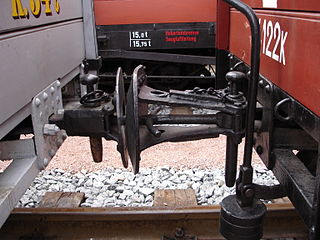Funnel coupling
The funnel coupling is one of the central buffer couplings . With the funnel coupling, rail vehicles (locomotives, wagons) are coupled to one another. The funnel takes on the function of the central buffer when the rail vehicles run into it.
In contrast to the fully automatic or semi-automatic Scharfenberg coupling , the coupling process with funnel couplings is not automated. The actual connection of the rail vehicles via a coupling rod, the coupling adapter or the coupling suspension ( balancing lever coupling ) takes place manually. As a result of this manual work, the coupling of vehicles with funnel couplings is associated with a greater risk of accidents, which early on led to the development of other forms of coupling between railway vehicles.
The design of the funnel coupling differs in terms of the connecting component.
The funnel coupling as a central buffer coupling design was mainly used on narrow-gauge railways and trams . In the various German countries the manufacturers and railway companies developed different forms of the funnel coupling.
Saxon design

Original design
When the first narrow-gauge railway was commissioned in Saxony in 1881 ( Wilkau – Kirchberg ), the narrow-gauge vehicles were equipped with the uniform funnel coupling. The originally used design had a short and a long funnel coupling on a vehicle. The short coupling is spring-loaded in the longitudinal direction, while the long coupling is rigid. The funnel couplings are rigid in the lateral and vertical directions. The connection between two funnel couplings is made with a kind of coupling rod - the coupling iron - using two bolts. Relative movements between the vehicles are compensated for by the large cutouts in the buffer plates.
The dome iron is always left in the large funnel. When not in use, it is pulled back into the large funnel and secured with the bolt in an additional hole so that it cannot be damaged in the event of shunting impacts. When the vehicles are pushed open while maneuvering, the still freely movable end of the coupling rod is inserted into the small funnel. If the position is correct, the connection is locked with the coupling bolt in the small funnel. Two side handles are used to guide the coupling iron.
The original design can still be seen today in some vehicles, especially the two-axle vehicles in Rittersgrün , Radebeul and Jöhstadt .
Funnel head
With the introduction of the Scharfenberg coupling on the Saxon narrow-gauge railways, a possibility was required to use both coupling systems in parallel over a longer period of time, and to change the coupling variant depending on the areas of application of the vehicles. To do this, a funnel coupling head is attached to the coupling shaft with two bolts. The Scharfenberg coupling head can be attached using the same attachment options. Due to the rigid Scharfenberg coupling, the coupling shaft can be moved laterally and vertically. It is guided to the side by the bogie below using springs. When operating with a funnel head, it is fixed in the middle position with a bracket or with bolts on the side because the connection via the coupling iron is not rigid. The funnel head can still be seen today on some of the museum railroad vehicles.
Trolleys are also equipped with funnel couplings, but these do not have a buffer function, and the center of the coupling is lower due to the necessary profile freedom when rolling up and down the standard track wagons. Long coupling rods compensate for the difference in height, there are cranked coupling irons for a short distance between the standard vehicle and the trolley.
Funnel coupling adapter
In order to be able to couple vehicles with funnel couplings and Scharfenberg couplings or regular vehicles with Scharfenberg couplings with trolleys during operational use, an adapter is used that has the right shape for the Scharfenberg coupling on one side and can be connected to the funnel coupling with a coupling rod opening on the other. When using the funnel coupling adapter, the coupling shaft is also fixed in the central position. In various literature, the funnel coupling adapter is referred to as a plug -on head, and the term elephant is also used colloquially by company railroaders .
Württemberg design
The Königlich Württembergische Staatseisenbahn opted for the "American System" when building its railways, which is why the first vehicles were originally equipped with simple funnel couplings. This type of coupling was soon abandoned on standard-gauge railways in favor of the hook-type coupling common on neighboring railways.
The Württemberg State Railways also opted for the funnel coupling for their narrow-gauge railways, where they lasted until the railways were closed and can still be found in the museum today. In contrast to the Saxon design, the clutches of both ends of the vehicle were made the same and the clutch was designed to be more massive than in other comparable designs due to the requirements. The couplings were connected by means of a coupling iron that was attached to the coupling funnel with an inserted bolt, the coupling nail . The dome nail was also secured against falling out with a split pin.
United States
Various funnel couplings were originally the common type of coupling in the USA . Due to the high risk of accidents, they were replaced from 1877 by the Janney coupling , which became mandatory in 1893 and has since become the standard coupling throughout North America.

